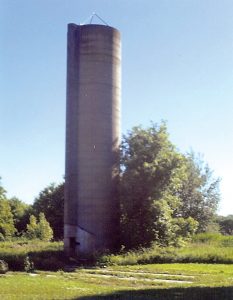Joe’s stories – old, new, mostly true Silo Series
Driving around almost anywhere in rural New York it is not uncommon to see one or more silos at current or former farmsteads. Some of course are still in use and others have lived long after their need ended. Most are of some similarity but there are some unusual ones that I’ve taken photos of and thought they might be interesting to others as they are to me.
 In the process I used the internet to research a little about silos. One definition is that they are an airtight structure that holds fresh organic matter, usually chopped corn, grass or other green plant material which ferments into a highly nutritious and palatable food for farm animals. Britannica credits scientist Frank H. King as being the inventor of the cylindrical tower silo. The word silo is said to be derived from the Greek word siros-a pit for holding grain, that was used in Greece as far back as the 8th century BC, as determined from remains found in archeological ruins.
In the process I used the internet to research a little about silos. One definition is that they are an airtight structure that holds fresh organic matter, usually chopped corn, grass or other green plant material which ferments into a highly nutritious and palatable food for farm animals. Britannica credits scientist Frank H. King as being the inventor of the cylindrical tower silo. The word silo is said to be derived from the Greek word siros-a pit for holding grain, that was used in Greece as far back as the 8th century BC, as determined from remains found in archeological ruins.
As noted the silage fermented and on most farms there was a pool of liquid at the base of the silo. This liquid did have an alcohol content and many hired hands would filter and consume that when they couldn’t afford the real stuff.
Silos were built from a variety of structural material, as we will see from other photos. The most common material for early silos in our area was wood. It was cheap and readily available. However, most of it needed to be treated to prevent rotting. Wooden silos eventually gave way to more durable materials that lasted longer and wouldn’t burn up if the barn burnt down.
The silo pictured stands on Route 3 in Oswego county. It is a sad but common site – a silo standing alone when all other evidence of a farmstead is gone. One can only imagine what was once there. Future articles will be primarily photos with some commentary about them.


